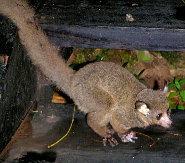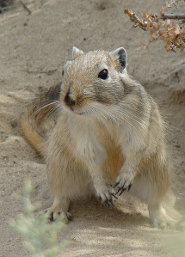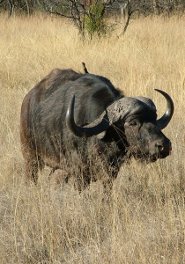Tuesday 18 December 2012
Greater Galago - an Amazing Jumper

The
greater galago (
Otolemur crassicaudatus), also knows as the bush baby or nagapie (which means "little night monkeys" in Afrikaans), is a small primate that spends most of its waking life during the night time. They come from the continental, forested areas of Africa. With large eyes for night vision and long bushy tails for balance, the greater galago has strong back legs for jumping as well as relatively large ears for a good sense of hearing. The majority of their toes have nails, rather than claws. However, the second toe of the back foot features a claw instead. The claw is used for personal grooming. The greater galago is somewhat omnivorous, consuming insects and other small animals as well as fruit and gum from trees. Their front teeth are somewhat comb shaped.
The greater galago is known for its jumping ability. They are capable of jumping straight upward as high as 2 meters, or 6.6 feet. This is much greater than is typically possible for an animal of this size, which weighs in between two and a quarter and four and a half pounds (one to two kilograms). This remarkable jumping ability is thought to be related to extremely elastic tendons located in their lower legs capable of storing a great deal of energy.
The greater galago grows in the womb for a period of a hundred and ten to a hundred and thirty three days. Once born, they are unable to move independently and their eyes are still half closed. After about a week, the mother begins carrying the baby galago around in its mouth, leaving it on tree branches in order to feed it.
Females of the species maintain a particular territory. That is, the females of the species are territorial, but they share the territory with their children. When the males hit puberty, they leave to stake out a new territory. The females remain with their mothers, building a social community of related females that watch over one another's children. In most cases, a male will seek out another female territory, mating with all of the females located within that territory. In cases where males are unable to do this, they will occasionally form their own community of males.
Greater galagos should not be kept as pets because they can be infected with diseases that are capable of spreading to humans, as is the case with most primates. Nevertheless, several people do keep them as pets, and customs officials find them being imported between countries. Length of life in captivity is about fifteen years, meaning that in the wild they likely live for roughly a decade.
Picture of the greater galago by buecherfresser, Kenya, August 2004, licensed under
GFDL
You can help spreading the word about this animal by liking it on facebook
Permanent Link
Tuesday 11 December 2012
The Great Gerbil - A Natural Grocer

The Great gerbil (
Rhombomys opimus), is not a critter to be trifled with. Far and away unlike the gerbils found in pet stores, the great gerbil can grow to 16 inches (40.6 cm) and achieve a weight of .0627 pounds or .0285 kg. A world traveler, the great gerbil has been found in a variety of countries, climates and habitats. This animal is one hardy rodent who gets around. Populations of great gerbils exist in China, Russia, Turkmenistan, Kazakhstan, Iran, Southern Mongolia, and Afghanistan. It's a desert-dweller for the most part, but the great gerbil easily adapts anywhere.
Its scientific name,
Rhombomys opimus, literally means "rich rhomboid mouse" because of the appearance of its teeth and the way it stores its food. Hoarders, the great gerbil stockpiles large quantities of groceries, foraging at dawn and dusk. If they can easily dig through the soil, they will bury their provisions to keep them safe. But in areas where the ground is rock-hard, they create little piles outside their nests. According to National Geographic, "Piles of food up to three meters across and a meter high have been recorded." (That's about 9 feet across and 3 feet high, quite a pantry).
The great gerbil is also a talented burrow-builder. Most likely they build strong burrows to protect their food stash, but also their families. They are gregarious animals, living in large extended families. A group of gerbils is called a "horde", a fitting name for animals who hoard their food.
These animals migrate often, always searching for more and better food. The burrows they leave behind become shelter for a variety of other animals that have been found living as squatters in an abandoned great gerbil burrow. Small mammals, birds, and insects have all been discovered living in gerbil burrows, which can be long and complicated in soft soil. Their traveling habits explain why they are found in so many countries. Their relentless search for sustenance has caused these gypsy gerbils to be listed as pests in many parts of the world. Especially for farmers and people who make their living in agriculture, the great gerbil is not so great for their livelihood. They destroy crops and damage irrigation systems, soil embankments and fields. Their enemies are any reptile, mammal or raptor fast enough to catch them, and
humans who trap them for their fur and to eradicate them from managed vegetation.
Picture of the great gerbil at Baikonur-town, Kazakhstan by Yuriy75, licensed under
GFDL
You can help spreading the word about this animal by liking it on facebook
Permanent Link
Monday 03 December 2012
African Buffalo - The Brawny Socialites

The
African Buffalo's (
Syncerus caffer) range stretches from North of South Africa to the south of Sahara Desert. Its main habitat mainly includes arid biomes and areas around rivers, swamps, and lakes. It is also found in open woodland regions.
The African buffalo is quite a heavy and large animal. Its weight can range from 500 kg (1100lbs) to 900 kg (1980 lbs) and its average weight is about 700 kg (1540lbs). Its total length from head to back can be around 2,100-3,000 mm and the length of the tail is around 750-1,100 mm. The height of African buffalo ranges from 1m to 1.7 m. This species has a very large head and strong limbs. Its chest is broad and ears are droopy and large. There is not any specific shape for its horns. They can spread outwards, downwards, or upwards. The two horns of the males are joined at the tip by a boss and they work as a shield covering the head. The various subspecies are found with different sizes such as the S.C.Caffer is double the size of S.C.Nana. The African buffalo is found in both black and brown colors. The young buffalos have thick covering of hair on their body but with age, they start losing hair and in old age, there is very little hair left on their skin.
Both, the male and the female gain their maturity at the age of 1674 days (4 years and 7 months) and there is no specific period of reproduction for African buffalos. It can occur the year around but seasonal rainfall can also influence the reproduction process. The Serengeti Plain experiences rainfall during February to July and at the end of the wet season, the conception period of the African Buffalo begins. The calf takes birth in the second half of the next wet season.
For 23 days, females remain in heat and the estrus period lasts for 5 to 6 days. Once the female has conceived, the gestation period is for 340 days, almost one full year. The female gives birth only to one calf at a time which weighs about 40 kg at birth. Male babies live with mother for only two years and then, leave the mother to join a bachelor buffalo group. Females do not leave the mother up to the time they are able to produce younger ones. A male reaches sexual maturity when it is 3 to 4 years old while a female attains maturity at the age of 5 years.
The African buffalo is a highly sociable animal that travels in large groups. These groups include females and the young calves they had given birth in the past two seasons. 3 to 4 males form a bachelor group during the dry season. There is also a dominance hierarchy within this group. There are fights among the members of every group for an estrous female. African buffalos are considered exceptionally powerful and they can run at a very high speed that can go up to 57 km/hr.
Picture of the African buffalo by Paul M Rae., licensed under
GFDL
You can help spreading the word about this animal by liking it on facebook
Permanent Link
 The greater galago (Otolemur crassicaudatus), also knows as the bush baby or nagapie (which means "little night monkeys" in Afrikaans), is a small primate that spends most of its waking life during the night time. They come from the continental, forested areas of Africa. With large eyes for night vision and long bushy tails for balance, the greater galago has strong back legs for jumping as well as relatively large ears for a good sense of hearing. The majority of their toes have nails, rather than claws. However, the second toe of the back foot features a claw instead. The claw is used for personal grooming. The greater galago is somewhat omnivorous, consuming insects and other small animals as well as fruit and gum from trees. Their front teeth are somewhat comb shaped.
The greater galago (Otolemur crassicaudatus), also knows as the bush baby or nagapie (which means "little night monkeys" in Afrikaans), is a small primate that spends most of its waking life during the night time. They come from the continental, forested areas of Africa. With large eyes for night vision and long bushy tails for balance, the greater galago has strong back legs for jumping as well as relatively large ears for a good sense of hearing. The majority of their toes have nails, rather than claws. However, the second toe of the back foot features a claw instead. The claw is used for personal grooming. The greater galago is somewhat omnivorous, consuming insects and other small animals as well as fruit and gum from trees. Their front teeth are somewhat comb shaped.
 The Great gerbil (Rhombomys opimus), is not a critter to be trifled with. Far and away unlike the gerbils found in pet stores, the great gerbil can grow to 16 inches (40.6 cm) and achieve a weight of .0627 pounds or .0285 kg. A world traveler, the great gerbil has been found in a variety of countries, climates and habitats. This animal is one hardy rodent who gets around. Populations of great gerbils exist in China, Russia, Turkmenistan, Kazakhstan, Iran, Southern Mongolia, and Afghanistan. It's a desert-dweller for the most part, but the great gerbil easily adapts anywhere.
The Great gerbil (Rhombomys opimus), is not a critter to be trifled with. Far and away unlike the gerbils found in pet stores, the great gerbil can grow to 16 inches (40.6 cm) and achieve a weight of .0627 pounds or .0285 kg. A world traveler, the great gerbil has been found in a variety of countries, climates and habitats. This animal is one hardy rodent who gets around. Populations of great gerbils exist in China, Russia, Turkmenistan, Kazakhstan, Iran, Southern Mongolia, and Afghanistan. It's a desert-dweller for the most part, but the great gerbil easily adapts anywhere. The
The